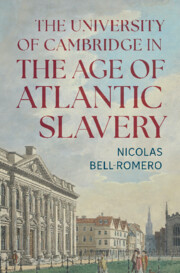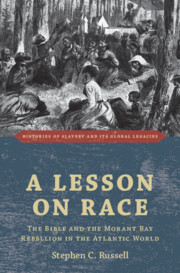Refine search
Actions for selected content:
202 results
4 - ‘Several University Gentlemen, who have quite altered their Tone’: The Problem of the British Slave Trade
-
- Book:
- The University of Cambridge in the Age of Atlantic Slavery
- Print publication:
- 30 October 2025, pp 104-137
-
- Chapter
-
- You have access
- Open access
- HTML
- Export citation
6 - ‘We presume that its influence is nowhere greater than in the Universities’: Ending and Defending American Slavery
-
- Book:
- The University of Cambridge in the Age of Atlantic Slavery
- Print publication:
- 30 October 2025, pp 164-201
-
- Chapter
-
- You have access
- Open access
- HTML
- Export citation
5 - ‘Those who wish to see the Slave System decline, and at length gradually and safely’: The Ambitions of Cambridge Abolitionism
-
- Book:
- The University of Cambridge in the Age of Atlantic Slavery
- Print publication:
- 30 October 2025, pp 138-163
-
- Chapter
-
- You have access
- Open access
- HTML
- Export citation
Introduction
-
- Book:
- The University of Cambridge in the Age of Atlantic Slavery
- Print publication:
- 30 October 2025, pp 1-18
-
- Chapter
-
- You have access
- Open access
- HTML
- Export citation

The University of Cambridge in the Age of Atlantic Slavery
-
- Expected online publication date:
- September 2025
- Print publication:
- 30 October 2025
-
- Book
-
- You have access
- Open access
- Export citation
The Death Penalty’s Abolition and Infanticide’s Invention: A Neglected Nexus
-
- Journal:
- Canadian Journal of Law & Society / La Revue Canadienne Droit et Société / Volume 40 / Issue 1 / April 2025
- Published online by Cambridge University Press:
- 05 June 2025, pp. 145-162
-
- Article
-
- You have access
- Open access
- HTML
- Export citation
1 - From Transnational Movement to Global Memory
-
- Book:
- Slavery in the International Women's Movement, 1832–1914
- Published online:
- 19 May 2025
- Print publication:
- 05 June 2025, pp 30-61
-
- Chapter
-
- You have access
- Open access
- HTML
- Export citation
2 - “Skin for Skin”: Paul Bogle
-
- Book:
- A Lesson on Race
- Published online:
- 22 May 2025
- Print publication:
- 05 June 2025, pp 30-49
-
- Chapter
- Export citation
5 - “Least of These”: Eliza Wigham
-
- Book:
- A Lesson on Race
- Published online:
- 22 May 2025
- Print publication:
- 05 June 2025, pp 87-105
-
- Chapter
- Export citation
1 - “These Things Happened”: The Rebellion
-
- Book:
- A Lesson on Race
- Published online:
- 22 May 2025
- Print publication:
- 05 June 2025, pp 12-29
-
- Chapter
- Export citation
3 - “A Good Fight”: George William Gordon
-
- Book:
- A Lesson on Race
- Published online:
- 22 May 2025
- Print publication:
- 05 June 2025, pp 50-67
-
- Chapter
- Export citation
6 - “Produce Your Cause”: The Bible
-
- Book:
- A Lesson on Race
- Published online:
- 22 May 2025
- Print publication:
- 05 June 2025, pp 106-122
-
- Chapter
- Export citation
2 - Young Hegel, Love and the Critique of Punishment
- from Introduction to Part I: Two Beginnings
-
- Book:
- Rethinking Criminal Justice
- Published online:
- 17 May 2025
- Print publication:
- 05 June 2025, pp 29-51
-
- Chapter
- Export citation
Conclusion
-
- Book:
- A Lesson on Race
- Published online:
- 22 May 2025
- Print publication:
- 05 June 2025, pp 123-127
-
- Chapter
- Export citation
Introduction
-
- Book:
- A Lesson on Race
- Published online:
- 22 May 2025
- Print publication:
- 05 June 2025, pp 1-11
-
- Chapter
- Export citation
To Agitate a Southern Audience: Revisiting the Impact of Abolition on Tuskegee Institute’s Institutional Interventions, Anti-Lynching Advocacy, and Sociological Contributions
-
- Journal:
- Du Bois Review: Social Science Research on Race , First View
- Published online by Cambridge University Press:
- 26 May 2025, pp. 1-25
-
- Article
-
- You have access
- Open access
- HTML
- Export citation

A Lesson on Race
- The Bible and the Morant Bay Rebellion in the Atlantic World
-
- Published online:
- 22 May 2025
- Print publication:
- 05 June 2025
European private law & intersectionality: three strategies
-
- Journal:
- European Law Open / Volume 4 / Issue 2 / June 2025
- Published online by Cambridge University Press:
- 25 April 2025, pp. 201-222
-
- Article
-
- You have access
- Open access
- HTML
- Export citation
Academic Copaganda – CORRIGENDUM
-
- Journal:
- Law & Society Review / Volume 59 / Issue 2 / June 2025
- Published online by Cambridge University Press:
- 28 March 2025, p. 461
- Print publication:
- June 2025
-
- Article
-
- You have access
- Open access
- HTML
- Export citation
1 - “Not Fit for the Enjoyment of Freedom”
-
- Book:
- The Overseer State
- Published online:
- 21 March 2025
- Print publication:
- 27 March 2025, pp 29-68
-
- Chapter
- Export citation
